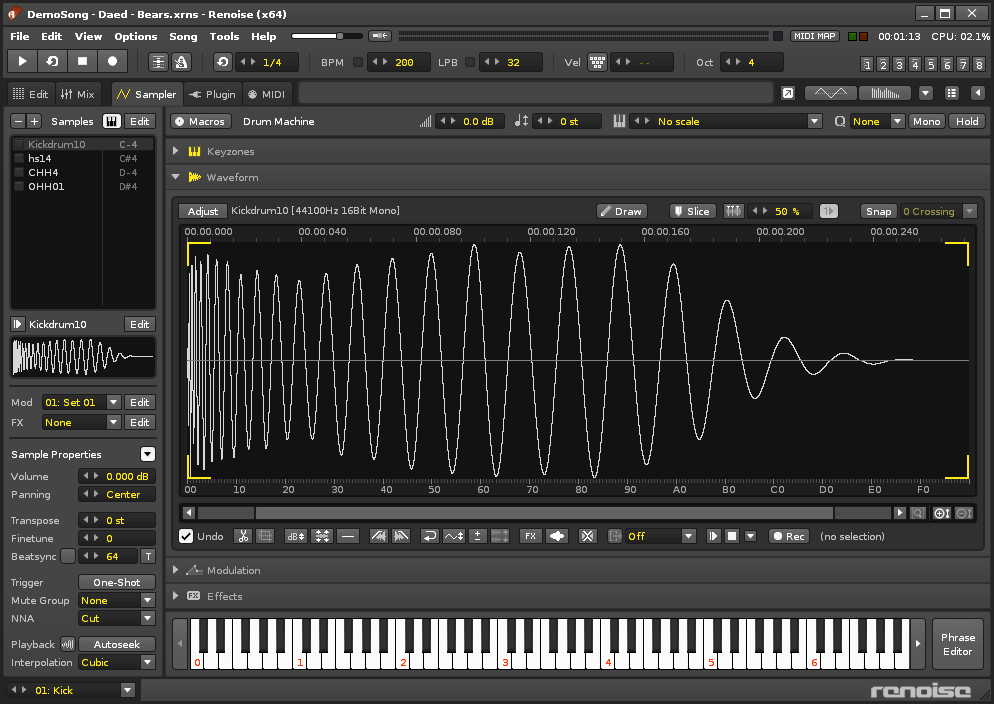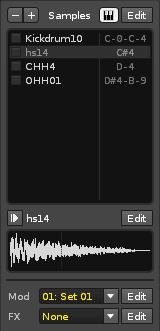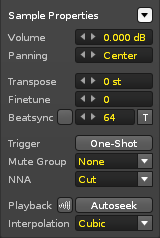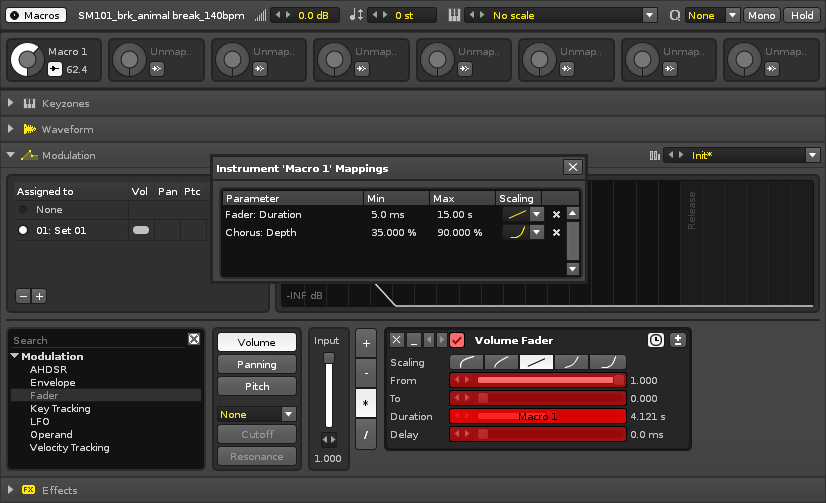Sampler: Difference between revisions
imported>Achenar No edit summary |
imported>Achenar No edit summary |
||
| Line 56: | Line 56: | ||
* '''Trigger:''' When enabled, Note-Off (key release) messages are ignored and the sample continues playing. This is incredibly useful for triggering samples from external hardware that is not traditionally 'held down' ''e.g. drum pads''. | * '''Trigger:''' When enabled, Note-Off (key release) messages are ignored and the sample continues playing. This is incredibly useful for triggering samples from external hardware that is not traditionally 'held down' ''e.g. drum pads''. | ||
* '''Mute Group:''' Samples which are assigned to the same Mute Group will ''"Cut"'' each other off in the same [[Pattern Editor#Tracks|track]]. A sample's Mute Group number is also displayed to the left of its name in the Sample List. Useful for drum kits, where triggering the same drum will realistically interrupt its previous sample, but not interfere with the other drum sounds. | * '''Mute Group:''' Samples which are assigned to the same Mute Group will ''"Cut"'' each other off in the same [[Pattern Editor#Tracks|track]]. A sample's Mute Group number is also displayed to the left of its name in the Sample List. Useful for drum kits, where triggering the same drum will realistically interrupt its previous sample, but not interfere with the other drum sounds. | ||
* '''NNA:''' New Note Action. When a note is in the process of playing and a new note is played in the same [[Pattern Editor#Columns|column]], NNA dictates how the previous note will behave. By default, | * '''NNA:''' New Note Action. When a note is in the process of playing and a new note is played in the same [[Pattern Editor#Columns|column]], NNA dictates how the previous note will behave. By default, samples will be set to ''"Note-Off"'', which stops the note and triggers any [[Playing_Notes_with_the_Computer_Keyboard#Note_Off|Note-Off actions]]. ''"Cut"'' will also stop the note's playback, but doesn't trigger [[Playing_Notes_with_the_Computer_Keyboard#Note_Off|Note-Off actions]], instantly silencing it. To achieve polyphony you normally just use multiple [[Pattern Editor#Columns|note-columns]], but by setting the NNA to ''"Continue"'', you can create the sustained playback of multiple notes using a single column. | ||
* '''Playback''' | * '''Playback''' | ||
Revision as of 16:23, 25 May 2015
Sampler
Renoise has a strong focus on samples and at the heart of this is a powerful built-in Sampler for creating and sculpting sounds. An instrument may contain any number of samples and these are always listed in the Sample List section on the left. The main central section of the Sampler is split into four different parts, each devoted to a different aspect of sample-based instrument construction.
Keyzones allow different samples to be triggered over a variety of note and velocity ranges. The Waveform editor displays the samples so you can edit them with the provided tools and see the results graphically. Adding Modulation and Effects to samples greatly expands the possibilities of their sound beyond the original audio.
New sounds can be recorded directly into the Sampler from external sources, or created by hand with the simple Draw tool. Any changes made to samples are exclusive to each individual Renoise song. The source samples are never modified unless you explicitly save and overwrite the file by saving it in the Disk Browser. Besides being non-destructive, the Sampler also supports endless undo/redo-ing of all your actions.
Sample List
Located at the left, this section provides a list of the instrument's samples and is always accessible no matter what central section you're working with, so you can switch between different samples whenever you wish. To select a sample, left-click on it in the list. This will also show the sample's name, waveform and assigned Modulation/FX sets at the bottom. When a sample is playing, the playback indicator to the left of its name will light up.
Selecting Multiple Samples
Left-click on a sample to select it. Now if you hold down "Left Shift" and left-click on another sample, both samples and any between them in the list will become selected. Holding "Left Ctrl" ("Command" on Mac) and left-clicking on samples will select/deselect them, allowing you to pick any combination from the list. When multiple samples are selected, any changes made to the Sample Properties will affect them all.
Controls
 - Delete the selected sample from the list.
- Delete the selected sample from the list. - Insert a new blank sample into the list.
- Insert a new blank sample into the list. - When enabled, a sample from the list will be automatically selected when it is played on the keyboard or by MIDI.
- When enabled, a sample from the list will be automatically selected when it is played on the keyboard or by MIDI. - Open the Keyzones editor. Note that the Keyzone range of each sample in the list is displayed to the right of it.
- Open the Keyzones editor. Note that the Keyzone range of each sample in the list is displayed to the right of it.
 - Preview the selected sample (the preview track is set in the Waveform editor).
- Preview the selected sample (the preview track is set in the Waveform editor). - Open the selected sample in the Waveform editor.
- Open the selected sample in the Waveform editor.
 - Assign a Modulation set to the selected sample. Pressing Edit will open the Modulation editor.
- Assign a Modulation set to the selected sample. Pressing Edit will open the Modulation editor. - Assign an FX set to the selected sample. Pressing Edit will open the Effects editor.
- Assign an FX set to the selected sample. Pressing Edit will open the Effects editor.
Note On/Off Layers
Samples can be triggered for either Note-On (key press) or Note-Off (key release) inputs. To move a sample to the Note-Off layer, right-click on its name in the Sample List and select "Move to 'Note-Off Layer'". Use the same method to move samples back to the Note-On layer. When there are samples using the Note-Off layer, tabs will appear at the top of the Sample List allowing you to switch between the layers and view the samples contained within.
Sample Properties
Directly under the Sample List, the properties of the currently selected sample(s) are displayed. The ![]() button at the top right toggles the opening and closing of this section.
button at the top right toggles the opening and closing of this section.
Options
- Volume: The sample playback volume.
- Panning: The panning of the sample.
- Transpose: Transpose the note playback in semi-tonal increments.
- Finetune: Fine-tuning of the Transpose value.
- Beatsync: When enabled, the sample's pitch will be automatically changed so that it lasts for the stated amount of pattern lines and is especially useful for syncing drumbeat loops. It will also automatically update its pitch if the song changes BPM. As a consequence though, the sample is 'locked' and you will be unable to use it at other pitches. As an alternative, you can leave the tickbox disabled and instead press the
 button, which will automatically set the Transpose and Finetuning values to match the current BPM, leaving you free to change them and play the sample at other pitches.
button, which will automatically set the Transpose and Finetuning values to match the current BPM, leaving you free to change them and play the sample at other pitches.
- Trigger: When enabled, Note-Off (key release) messages are ignored and the sample continues playing. This is incredibly useful for triggering samples from external hardware that is not traditionally 'held down' e.g. drum pads.
- Mute Group: Samples which are assigned to the same Mute Group will "Cut" each other off in the same track. A sample's Mute Group number is also displayed to the left of its name in the Sample List. Useful for drum kits, where triggering the same drum will realistically interrupt its previous sample, but not interfere with the other drum sounds.
- NNA: New Note Action. When a note is in the process of playing and a new note is played in the same column, NNA dictates how the previous note will behave. By default, samples will be set to "Note-Off", which stops the note and triggers any Note-Off actions. "Cut" will also stop the note's playback, but doesn't trigger Note-Off actions, instantly silencing it. To achieve polyphony you normally just use multiple note-columns, but by setting the NNA to "Continue", you can create the sustained playback of multiple notes using a single column.
- Playback
- Autofade: Automatically inserts a quick fade at the beginning and end of a sample. Useful for preventing unwanted audio clicks.
- Autoseek: During song playback a sample is normally only heard once it has been triggered by reaching its position in the pattern. Enabling Autoseek allows the sample to be heard at any point during song playback without the need for triggering. Highly recommended for vocals, background ambience and other lengthy recorded audio.
- Interpolation: This is the quality of re-sampling used when samples are played at pitches other than the original. "Cubic" is an excellent default interpolation, offering the best ratio between sound quality and CPU usage. "Sinc" is more precise but requires more CPU power, while "Linear" is the opposite and sounds rougher when played at lower pitches. Set to "None", samples will sound a bit more metallic and rough, which can be good if that's the kind of sound you're after and is also useful when creating wave-table generators with very short sample loops.
Macros
Macros allow the automation of a sample-based instrument's modulation and fx parameters via the *Instr. Macros track effect. Pressing the ![]() button, located at the top left corner of the instrument editor, will open a panel with eight macros, each of which can be assigned to any number of parameters. Altering a macro's value will then alter the values of all assigned parameters.
button, located at the top left corner of the instrument editor, will open a panel with eight macros, each of which can be assigned to any number of parameters. Altering a macro's value will then alter the values of all assigned parameters.
To map a macro, press the ![]() button to open the mappings list and reveal any mappable parameters (by default, highlighted in red). Clicking on a parameter will add it to the list and allow you to specify its Min/Max values and Scaling. Pressing the X at the right will delete the mapping. To rename a macro, just click on its name.
button to open the mappings list and reveal any mappable parameters (by default, highlighted in red). Clicking on a parameter will add it to the list and allow you to specify its Min/Max values and Scaling. Pressing the X at the right will delete the mapping. To rename a macro, just click on its name.
You can also access the macros in the Instrument Properties section under the Instrument Selector.



